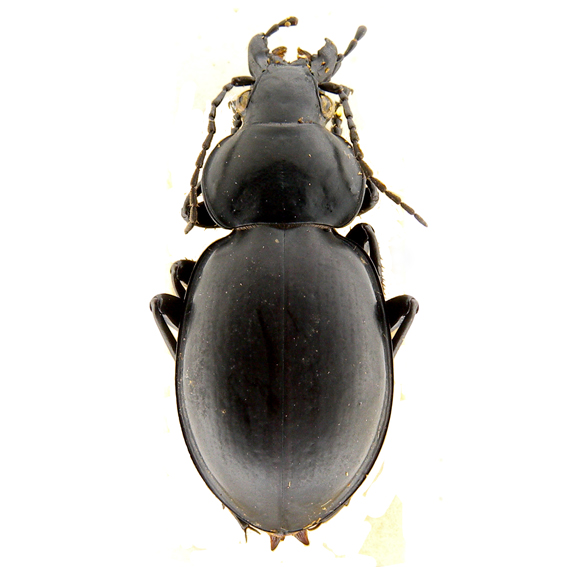Calosoma (Carabomimus) laevigatum Chaudoir, 1869
Calosoma laevigatum Chaudoir, 1869: 374 (type material: 1 ♂ , ex coll. Laferté, from Mexico); holotype ♂ (no locality label) designated by Deuve (1978: 251) by monotypy in Muséum National d'Histoire Naturelle, Paris [examined]
Calosoma (Blaptosoma) striatulum ssp. laevigatum Breuning, 1928: 49
Carabomimus laevigatus Jeannel, 1940: 226
Calosoma (Carabomimus) laevigatum Gidaspow, 1959: 291
Length 19-22 mm. C. laevigatum has a characteristic elongated oval shape. The pronotum has only slightly arched sides and the elytra are almost smooth with imperceptible traces of sculpture. The penis falls within the model of C. politum with a slight more enlarged apex. However it differs from politum because it is slightly larger in size, and because it has less transverse pronotum and more elongated elytra. It differs also from the population with smooth elytra of C. striatulum (libresensis), that has a similar body shape, because the apex of the aedeagus lacks the characteristic hatched ledge.
Chaudoir, (1869: 374) described C. laevigatum from an unprecise locality of Mexico. Breuning and Jeannel knew laevigatum only from Hidalgo on specimens collected by Höge. Gidaspow (1959: 291) writes that C. laevigatum should be widespread in all states of the south-eastern Mexico, Guanajuato, Hidalgo, Puebla (Sierra Negro), Vera Cruz, up to the state of Durango. Finally, other authors (Lassalle & van den Berghe, 2011b : 297), who have been recently exploring in depth the same areas of central Mexico, wrote that C. laevigatum should be confined to the high altitude mountain areas north of Mexico state and south of Hidalgo, from where all the specimens that we could examine, come and to which we can add a recent sighting in the eastern part of the state of Michoacan.
However there are specimens of C. laevigatum, preserved in the collection of EH Strickland Entomological Museum of the University of Alberta, that have been captured at Puebla (Tlaxco, Tlachichuca) and Vera Cruz (Cofre de Perote, Pico de Orizaba). Moreover there are the quotes relative to C. laevigatum from biosphere reserve La Michilia in the state of Durango (Ball & Shpeley, 1991: 43). All these data seem to confirm the distribution area of C. laevigatum as indicated by Gidaspow.
We have not seen the specimens referred to in the quotation above referred and, before drawing a distribution of this species into two largely separated areas, we must suspend judgment, and wait for further confirmation. On the other end, before accepting the sympatry with C. striatulum, we have to remember the superficial similarity between the two species (specially with regard to slightly larger individuals of C. striatulum, having almost smooth elytra) if one does not take into account the differences in the shape of apex of aedeagus.
Examined specimens and literature’s data
Mexico. Durango: La Michilia (Ball & Shpeley, 1991: 43); Hidalgo: Real del Monte (Bates, 1891: 225; AMNH), Ajacuba (Gidaspow, 1959: 291); Mexico: between S. Juan del Rio and Atlacomulco 2700 m (AVT, EM, SB); Michoacan: Tzintzuntzan (www.inaturalist.org/obs./122883910); Puebla: Sierra Negro (Gidaspow, 1959: 291), Tlaxco, Tlachichuca (UASM); Vera Cruz: Cofre de Perote, Pico de Orizaba (UASM).
Notes: Brachypterous. It has been found on field and pastures under stones and blades of prickly pear on the ground in July, but according to Erwin (2007: 97) it is diurnal, as well as nocturnal, and lives also in fir forests where it is active in April-June and August.
The descriptions of the third and second-instar larvae, are found in Vigna Taglianti & al., (2021: 89-91).
 Chaudoir, 1869 Mexico, between S. Juan del Rio and Atlacomulco, Puerto Cruz Colorada 2700m, 17/18.VII.1987, S. Bruschi leg. |
 Chaudoir, 1869 Mexico, between S. Juan del Rio and Atlacomulco, Puerto Cruz Colorada 2700m, 17/18.VII.1987, S. Bruschi leg. |